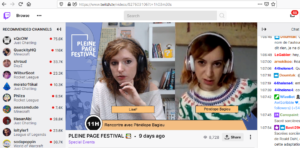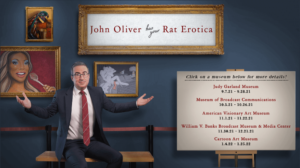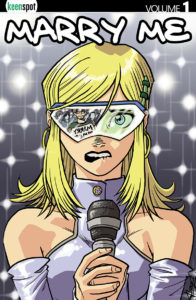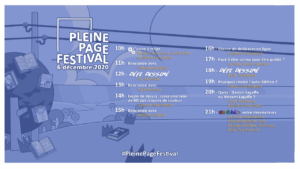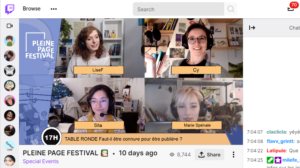An Interview With Pénélope Bagieu Is Always A Welcome Thing
And one in such exquisite detail even more so.
Welcome back to the coverage of this year’s Quai des Bulles festival, courtesy of Fleen Senior French Correspondent Pierre Lebeaupin. As mentioned in Part One, this is his report on the career retrospective interview of Pénélope Bagieu.
The interview took place Saturday at 2:30 PM in the Amphithéâtre Maupertuis, with Vincent Brunner interviewing.
30 minutes before the start, available spots were already thinning out. 15 minutes bore the start, there was no room left at all.
When Pénélope Bagieu entered the room, the audience broke into applause.
After a welcome message, a reminder of her exhibition, and a quick recap of her career, including her Eisner award, the interview started in earnest.
Brunner: How did she realize she wanted to become a comics creator, with so few examples, such as Claire Brétécher?
Bagieu: As far as her young self was concerned, the comics she read appeared out of thin air without anyone needing to be involved, and in fact she noticed female protagonists more than female creators. Later on she studied animation, then worked in illustration, at which point she started being commissioned for comics work as part of her job, and that turned out to be to her liking.
She realized she had been doing comics as a teen (typically girls playing sports, inspired by Attacker You), but she did not think of it at the time as being comics.
Brunner: So she created a blog, a new medium at the time.
Bagieu: She was not interested then in putting out a book; she had always been doing commission work, as she was hired straight out of school, so the blog provided her with a space to express herself freely: no need for any of it to provide a return on investment. In the end, it was a training ground for her to be able to make books eventually.
Brunner: And it provided her direct interactions with the public.
Bagieu: Not necessarily as interactive as with some since her blog did not have comments, but yes that meant being exposed to many people, but pre-Instagram standards. It was an ongoing entertainer job: back then when you went on holidays you used to ask another creator to cover your away days! Today she couldn’t imagine doing the same: she’s just too busy.
The blog removed some of the solemn aspect of books: she never stopped herself thinking: This joke is going to end up in a book and enter the public record! She enjoyed the lack of restraint. She found it nice for it to become a book in the end, but that was never the end goal. Now she has better outlook on the process: for instance, it has become apparent visitors do not necessarily translate to sales.
Brunner: This is where Joséphine starts.
Bagieu: It was a commission work, and her first character in fiction, so the matter was finding out in which scenarios, in which contexts, and between which characters she was going to be inserted. Once she had consistent characters, it was just a matter of coming up with setups such as the company party at which point the stories write themselves, even after 20 years.
Brunner: Then a movie.
Bagieu: Joséphine was a kind of training camp, and once it had stopped being fun to do, she stopped. She hasn’t regretted it, even when in Japan when she got asked for more at a signing (the Japanese public is more interested in the pictures than in the stories of comics of the French-Belgian tradition). She is proud of it being her first published book in Asia.
Brunner: Isn’t there always some part of treason when adapting for a movie?
Bagieu: To avoid feeling betrayed, you either do it yourself (which as a creator you always have the option to do, by law, as part of your moral rights), and you’re safe; or you put it in the hands of someone else and own up already that it’s going to be their work.
She find movies to be a source of frustration as compared to comics: in the latter, she can afford to put ellipses for instance, and one person can have total creative control, without sharing it with actors, the people responsible for lighting, sets, or props. That means it’s solitary work, but it’s fine for her.
Brunner: Exquisite Corpse was another milestone.
Bagieu: She had huge worries going into it: was she going to succeed, in particular when it comes to writing? But it didn’t matter in the end: she had fun working on it, and it was the start of a realization that once everything is said and done, the only thing that remains out of a book is the experience she has had working on it, as far as she’s concerned, so the only thing that matters is how much she enjoyed herself doing it.
Brunner: Does she follow any sort of process when creating a book?
Bagieu: She does write a synopsis ahead of time for validation, which is always a source of worries, but beyond that no particular methodology. So she works on her books in an almost school-like manner: plan, introduction, development, conclusion. Other creators may follow different methods: some start without necessarily knowing how the book will end.
Brunner: What form does this take?
Bagieu: A mix of words, arrows, roughs, sketches, in order the represent the staging in her head, and which only she can make heads or tails of it. They are literally impossible to display: it’s hard to even know which orientation the sheet is meant to have.
Brunner: And she has also worked with writers.
Bagieu: At the time of her being proposed La Page Blanche (which occurred before Cadavre Exquis), she requested being paired with a writer, and ended up with Boulet, which was great, in particular so she could concentrate on the illustrations, and moreso the colors: I handle the writing duties.
But she did get frustrated somewhat, as she missed not so much writing the story, as being able to stage it, which is the part she loves best. Stars Of The Stars* was another attempt at drawing someone else’s scenario, this time with Johann Sfar, who had initiated the project. None of this being out of the ordinary: there are no two pairs of writers and artists who collaborate the same way, no two writers who are alike. Sfar taught her a lot, she finds him to be an incredible storyteller.
In the end, she decided she did not want anyone else writing stories for her to draw anymore, even if she isn’t the best writer. And even if that meant leaving Stars Of The Stars stranded with a single tome.
Brunner: What kind of tooling did she use?
Bagieu: Back then, Photoshop and graphic tablet: it was just easier for her. Sometimes you have to find the right tool, as for California Dreamin’, but sometimes also get out of your comfort zone.
Brunner: On that matter, why did she draw this story?
Bagieu: First of all, she’s of course a huge fan. And she found Mama Cass’s story to be incredible and felt the need to transmit it. Her penciling came alive on the page, but any inking froze that, so she decided she would do it all in pencils.
This was her first long-haul book; she loved the feeling of spending 18 months with someone, so she came to appreciate creating biographies. If only she could tell of more women that way …
Brunner: What kind of documentation did she use for that?
Bagieu: Immersing yourself in a setting for the purpose of writing, that sounds fantastic! So she travelled to New York City, sleeping in a B&B in Greenwich Village and spending her days in cafés, and by the end of the week the book was basically written.
Brunner: To which extent does she embellish these life stories with fiction?
Bagieu: She prefers biographies that don’t lean heavily on factuals, as opposed to those that go on that date they did this then that date they did that: the biographies that made a mark on her were those from which readers received love for the person, doesn’t matter if there’s a 20-year time skip in the middle.
Which does not mean she gets to do as she pleases: there are extant relatives who could object. So she had to double-check biographical details: whether they were raised in a rich or poor family, the kind of siblings they had, etc. Her role is to provide embellishments and draw the lines between the given points as she prefers. Out of the truth, shape her own Mama Cass: the one she wants to see.
On that note, if you need background characters who nevertheless need to stay consistent from panel to panel, use your own relatives.
She’d rather introduce the subject to the reader and make him love them, rather than teaching him information.
Brunner: Did she hear from the rights holders?
Bagieu: They refused to license the lyrics, so yes she did hear about them … But other than that, when she went to Baltimore, she got feedback from someone from her parents’ generation that she did render well the high school ambiance, which she did not expect but was glad to hear.
Brunner: So what’s the relationship with Brazen?
Bagieu: Let’s do a Katia Krafft bio! No, it’d be better to do a Peggy Guggenheim one! Wait, what if I did 30 of them? She was looking for a format with Le Monde: what if she did women bios, told as children’s tales of sorts, and randomly said 30 as to how many, once every Monday? She went on to call her publisher, who said it’d have to be two books then.
Brunner: How did she settle on which ones to write?
Bagieu: She had settled on about 2/3rds of them right away, and the last third came during the course of the project: she got heaps of suggestions, not to mention those who did not make the cut and still regrets. Some who were suggested she passed on because she found them to be sufficiently well-known already, but it could also be because their stories did not connect with her. But sometimes it was love at first sight, such as when Lisa Mandel suggested Phoolan Devi¹ to her.
Brunner: That was quite a synthesis work. What was her process?
Bagieu: Oh yes, there we do learn information. She started the week with their biographies, then she’d have about two days to write and draw their chapter. This was a good exercise, as with such constraints this is what hit her that remains, and in particular their switch: the trigger, the one event where they go I’m done playing by the rules, I’m going to live my life how I decide (either in terms of career, lifestyle, etc). That was in fact her main contribution to the animated version: confirming, and in some cases reminding, of where that spot happens in the stories.
Brunner: How did she handle the publishing schedule?
Bagieu: She did do a few ahead of time, for use in rainy days and the like. But the immediate feedback kept her very motivated, as opposed to her latest book which she was done drawing back in May but isn’t out yet … (Author’s note: at the time this interview was conducted)
Brunner: No sequel then?
Bagieu: No, she’s sticking with the 30 she initially committed to. Tove Jansson never lost sight of her priorities in life, and she’s taken that in turn: she knows that if she works on something she’d rather not work on, readers will notice.
Brunner: So she has no regret on any particular one who did not make the cut?
Bagieu: No, not on one in particular, and anyway there’s nothing stopping her from from discovering more women and reading their biographies.
Brunner: And it was not intended for children specifically, was it?
Bagieu: And yet, there they are.
Brunner: Which leads us to The Witches.
Bagieu: As far as she’s concerned, the children audience is demanding, as you can’t bluff your way out, which is especially the case for drawings: she holds children book illustrators in highest esteem. So when she inadvertently brought a younger readership, she realized it was not necessary to write in a way that targets them. As a result, when she got the offer to adapt Roald Dahl, she was less afraid to do so.
That still meant some pressure, especially for backgrounds: she herself as a young reader demanded to be able to witness everything, down to the smallest detail. Luckily, everything was there in the book already: scary antagonists, funny moments, actual action. He was pretty much the only writer in children’s literature to introduce somber themes.
When she first read the book she was aged about the same as the protagonists, so it helped her get back to the right frame of mind.
Brunner: And it’s a book about grandmothers.
Bagieu: She drew a lot from her own grandmother, as part of generally making an imprint on the story: rather than being an illustrator like Quentin Blake, she was adapting the book and so needed for it to become her own, so the grandmother went from being Dahl’s to being hers as a result. As well as making a character into a girl.
Brunner: Yes, that Bruno character.
Bagieu: He made no impression on her at all, so she wondered: why is he here at all? Let’s replace him, and as we’re at it by a girl who is interesting, has her own backstory, and serves some story purpose.
Brunner: Haven’t witches evolved since then?
Bagieu: It was complicated to adapt The Witches in 2020. But it mattered for them to remain fairy tale witches, as that is what worked for her at the time, because they were impressive. But there is the grandmother who exposes and is a different kind of witch.
Brunner: What were the rights holders like?
Bagieu: A single person in fact, who was open to anything that made sense. He was very settled on some aspects: the setting being England for instance. But he accepted a female character who made sense. He reminded her of an important theme: the grandmother has to love her grandchild no mater what, and it has to be shown.
Brunner: And she created it on the road.
Bagieu: During her Brazen promo tour, so she remembers every page being done in a train or in a waiting room. The iPad was very useful for her: for instance the pencil effect, as seen in this page.
Brunner: And we get to her latest, Strates, set to release on November 10th …
Bagieu: And available at the Gallimard booth ahead of the public launch.
Brunner: Where she gets back to autobio, with moments that made an impression on her.
Bagieu: On the blogs you take highlights out of your life and make scenes out of them, without really exposing yourself: everything has to be made into comedy. Here she collected deeply personal stories, some of which aren’t funny. But it’s a jigsaw puzzle of elements that built her, out of very diverse subject matters, even if some of them appear unimportant at first glance.
Brunner: There is not even any consistent page count.
Bagieu: She’s trusting the reader to follow. This one story she wrote down ten years ago. Then years later she did three in a month. This was originally a cathartic process not meant for anyone else, but eventually she decided she should not be afraid to make a book out of it.
For this, she redrew some of the oldest ones. She thought to herself that if this was enjoyable to make, it would have to be enjoyable to read. But it’s still not easy for her, as she puts herself bare in these pages. With any luck, she hopes it has some universality and impresses other people in turn.
Audience Member: She went from bios, to an adaptation, to autobio; what’s next?
Bagieu: She does not know herself. About one week before heading into it in earnest, she’ll know. It’s never the same thing twice, because she easily gets bored. Right now she wants to do colors, painting, as Strates is in black and white; if she’s still in that state of mind in a few weeks, she’ll attempt a few pages, and if after three pages it’s still too hard, she’ll give up.
Audience Member: What would be her advice for starting out?
Bagieu: She’s not comfortable providing such advice: she started out in days that are now fully gone, and wouldn’t know how to start over today. But people today are lucky to have Instagram, even if that imposes a format constraint, which she could get bored of: she worries about Instagram formatting stories for swiping as early as inception, for fear of there not being nearly as much of an outlet for them otherwise.
Also, there are some things that shouldn’t be shown right away and need to mature, because feedback on them would catch the ego in too fragile a state.
But it is key to generally show, otherwise you never work up the nerve to do so.
Don’t worry about what pleases the public, as you’re never going to be able to hold that up in the long run: you’re going to get sick of it. Same for artificial constraints: your work as to be personal, and that comes from drawing a lot; that is how your style comes, you don’t decide it.
Existing in an era of abundance requires being demanding with the editing side: you have to demand being backed up and respected, so be careful. You must speak with other creators so as to avoid being alone, to counteract the tendency of being solitary already.
Audience Member: Do woman creators earn less?
Bagieu: Yes, big surprise here: statistically advances are lower for female creators. There has always been female creators (and readers) but now they’re spreading to other parts of the book chain, such as editors.
Things have changed in the last ten-fifteen years, and besides feminization, some commercials successes have forced the attention on them; but women creators are still invisibilized in many cases, or assigned to some boxes, etc.
It’s not the worst occupation in that regard, but not the best either. But now female creators are banding, under the descriptively-named umbrella of Collectif des Créatrices de Bandes Dessinées.
Audience Member: (Author’s note: a young girl who happened to be next to me) How did she learn how to draw?
Bagieu: As the audience member did: pencils and paper which was laying around, then art school after high school. But there are some self-taught creators, who draw better than her.
One additional piece of advice, on that matter: she herself drew a lot because she was made to treat paper and pencils as mundane: the paper won’t serve for any other purpose since there’s a bill on the other side, the pencils are old but abundant, so she was free to draw a lot. The opposite of the shiny Caran d’Ache painting set. Given disposable materials like old markers: you go ahead.
Audience Member: What kind of representation, of feminine role model did she have?
Bagieu: No, she did not know women who drew, or even the people who did: the question of who were creating comics did not occur to her. She did love Mafalda and anime as they featured girls, they were part of the action. Sometimes stories were stereotypical girl stories: rivalries, pests, etc., but it was cool to have girl protagonists. For her the golden era of French-Belgian comic book heroines starts now, with the female creators who are 20-25 today.
Audience Member: What kind of pressure does she have after her previous successes, in particular Brazen?
Bagieu: Now everything she does will be widely read as being from the creator of Brazen. Including when unrelated, such as Strates. But in the worst case, she has already put out a best-seller, so that’s something taken care of already. She’s in awe of the other creators who can keep doing books in a series, because she on the other hand has to be passionate about her work. It helps to be well backed up, and not necessarily driven to what will make the most money.
And that will wrap this year’s report from St Malo. As always, we at Fleen are grateful for the contributions of FSFCPL, and all the hard work he puts in to keep us informed of the state of webcomics in the French tradition.
Spam of the day:
The ZoomShot Pro is the new tactical zoom for smartphones and tablets that resists all types of terrain and that with its magnification up to X18 will allow you to take the best photos outdoors without the need to carry a professional camera.
Make up your mind and decide on your audience: are you trying to scam warrior wannabes with the tactical angle, or serious photographers. This is just muddled.
_______________
¹ Editor’s note: Phoolan Devi, the Bandit Queen of India, was the one subject in the original French edition that was omitted from the US/Canada translation of Brazen.

